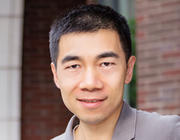A. Agaskar and Y. M. Lu, “
An uncertainty principle for functions defined on graphs,” in
Proc. SPIE Conf. on Wavelets and Sparsity, San Diego, 2011.
AbstractThe classical uncertainty principle provides a fundamental tradeoff in the localization of a function in the time
and frequency domains. In this paper we extend this classical result to functions defined on graphs. We justify
the use of the graph Laplacian’s eigenbasis as a surrogate for the Fourier basis for graphs, and define the notions of "spread" in the graph and spectral domains. We then establish an analogous uncertainty principle relating the two quantities, showing the degree to which a function can be simultaneously localized in the graph and spectral domains.
 graphuncert.pdf
graphuncert.pdfSee, also, the extended journal version: A. Agaskar and Y. M. Lu, A Spectral Graph Uncertainty Principle, IEEE Transactions on Information Theory, to appear.
Z. Sadeghipoor, Y. M. Lu, and S. Susstrunk, “
Correlation-Based joint acquisition and demosaicing of visible and near-infrared images,” in
Proc. IEEE International Conference on Image Processing, Brussels, 2011.
AbstractJoint processing of visible (RGB) and near-infrared (NIR) images has recently found some appealing applications, which make joint capturing a pair of visible and NIR images an important problem. In this paper, we propose a new method to design color filter ar- rays (CFA) and demosaicing matrices for acquiring NIR and visible images using a single sensor. The proposed method modifies the optimum CFA algorithm proposed in [1] by taking advantage of the NIR/visible correlation in the design process. Simulation results show that by applying the proposed method, the quality of demosaiced NIR and visible images is increased by about 1 dB in peak signal-to-noise ratio over the results of the optimum CFA algorithm. It is also shown that better visual quality can be obtained by using the proposed algorithm.
 visnir_icip11.pdf
visnir_icip11.pdf Y. M. Lu and M. Vetterli, “
Sparse spectral factorization: Unicity and reconstruction algorithms,” in
Proc. IEEE International Conference on Acoustics, Speech and Signal Processing, Prague, 2011.
AbstractSpectral factorization is a classical tool in signal processing and communications. It also plays a critical role in X-ray crystallography, in the context of phase retrieval. In this work, we study the problem of sparse spectral factorization, aiming to recover a one-dimensional sparse signal from its autocorrelation. We present a sufficient condi- tion for the recovery to be unique, and propose an iterative algorithm that can obtain the original signal (up to a sign change, time-shift and time-reversal). Numerical simulations verify the effectiveness of the proposed algorithm.
 sparsesf_icassp11.pdf
sparsesf_icassp11.pdf Y. M. Lu, P. L. Dragotti, and M. Vetterli, “
Localizing point sources in diffusion fields from spatiotemporal measurements,” in
Proc. Int. Conf. Sampling Theory and applications (SampTA), Singapore, 2011.
AbstractConsider a diffusion field induced by a finite number of localized and instantaneous sources. In this paper, we study the problem of estimating these sources (including their intensities, spatial locations, and activation time) from the spatiotemporal samples taken by a network of spatially distributed sensors. We propose two estimation algorithms, depending on whether the activation time of the sources is known. For the case of known activation
time, we present an annihilating filter based method to estimate the Euclidean distances between the sources and sensors, which can be subsequently used to localize the sources. For the case of a single source but with unknown activation time, we show that the diffusion field at any spatial location is a scaled and shifted version of a common prototype function, and that this function is the unique solution to a particular differential equation. This observation leads to an efficient algorithm that can estimate the unknown parameters of the source by solving
a system of linear equations. For both algorithms proposed in this work, the minimum number of sensors required is d + 1, where d is the spatial dimension of the field. This requirement is independent of the number of active sources.
 point_diffusion_sampta11.pdf
point_diffusion_sampta11.pdf J. Ranieri, A. Chebira, Y. M. Lu, and M. Vetterli, “
Sampling and reconstructing diffusion fields with localized sources,” in
Proc. IEEE International Conference on Acoustics, Speech and Signal Processing, Prague, 2011.
AbstractWe study the spatiotemporal sampling of a diffusion field generated by K point sources, aiming to fully reconstruct the unknown initial field distribution from the sample measurements. The sampling operator in our problem can be described by a matrix derived from the diffusion model. We analyze the important properties of the sampling matrices, leading to precise bounds on the spatial and temporal sampling densities under which perfect field reconstruction is feasible. Moreover, our analysis indicates that it is possible to compensate linearly for insufficient spatial sampling densities by oversampling in time. Numerical simulations on initial field reconstruction under different spatiotemporal sampling densities confirm our theoretical results.
 sparse_source_icassp11.pdf
sparse_source_icassp11.pdf I. Dokmanić, Y. M. Lu, and M. Vetterli, “
Can one hear the shape of a room: The 2-D polygonal case,” in
Proc. IEEE International Conference on Acoustics, Speech and Signal Processing, Prague, 2011.
AbstractWe consider the problem of estimating room geometry from the acoustic room impulse response (RIR). Existing approaches addressing this problem exploit the knowledge of multiple RIRs. In contrast, we are interested in reconstructing the room geometry from a single RIR — a 1–D function of time. We discuss the uniqueness of the mapping between the geometry of a planar polygonal room and a single RIR. In addition to this theoretical analysis, we also propose an algorithm that performs the "blindfolded" room estimation. Furthermore, the derived results are used to construct an algorithm for localization in a known room using only a single RIR. Verification of the theoretical developments with numerical simulations is given before concluding the paper.
 can_you_hear_icassp11.pdf
can_you_hear_icassp11.pdf(This paper received the Best Student Paper Award of ICASSP.)
